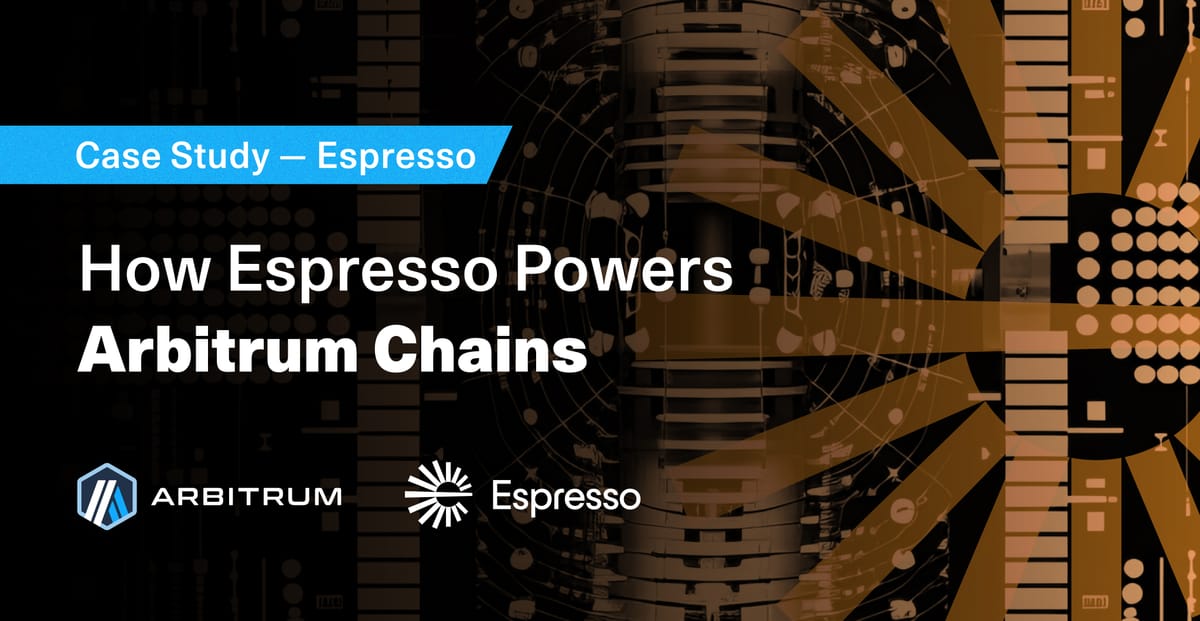How Espresso Powers Arbitrum Chains

Solving for blockchain fragmentation has been an ongoing technical challenge for developers in the web3 space. As the number of chains grow, so do challenges around UX, interoperability, security and liquidity transfer. Traditionally, if rollups want to interoperate with other rollups, they’re required to make a choice between slow but secure messaging, or fast messaging that requires trusting each other’s sequencers.
This is where Espresso comes in. Arbitrum chains that plug into Espresso don’t need to sacrifice security for speed, or vice versa.
Espresso is a purpose-built base layer for rollups that Arbitrum chains can use to enhance their security and more seamlessly connect with each other. It finalizes rollup blocks in seconds, and allows developers to build applications that span across various chains. It’s designed to be agnostic when it comes to tech stack, VM, or even settlement layer.
Composability Without Compromise
Most rollups today rely on Ethereum to finalize their blocks. Ethereum is one of the most trusted settlement layers, but can take up to 15 minutes or more to finalize blocks, discouraging real-time composability. Espresso steps in here as a confirmation layer that sits in between rollups and Ethereum.
What does this look like in practice? When an Arbitrum chain integrates with Espresso, its sequencer (yes, chains can maintain their own sequencer) publishes its blocks to Espresso before Ethereum (or Arbitrum One in the case of Orbit L3s). Espresso's validators run a BFT consensus protocol called HotShot to reach agreement on the block ordering and content. This process provides confirmations in ~5 seconds - much faster than waiting for Ethereum finality.
This architecture preserves an Arbitrum chain’s ability to provide ultra-fast preconfirmations to users while adding Espresso’s more secure confirmations as an additional security layer.A key security benefit is that Espresso prevents sequencer equivocation: once a block is confirmed by Espresso, the chain cannot post a different version to Ethereum (or Arbitrum One). This non-equivocation guarantee means that users, applications, and other chains can trust Espresso confirmations without waiting for Ethereum settlement. For developers, this unlocks real-time cross-chain composability within the Arbitrum ecosystem.
Prospective Arbitrum chains should speak with their RaaS providers to gain an understanding of how to utilize Espresso. An Espresso integration requires chain operators to operate a Nitro fork.
Making Waves in the Arbitrum Ecosystem
Espresso is currently powering a handful of Arbitrum chains, most notably RARI Chain, LogX and AppChain. These chains are already benefiting from Espresso’s added security and fast confirmations, as well as Espresso’s successful ecosystem growth initiatives.
RARI Chain, for example, became the home of the Espresso Foundation’s NFT project, The Composables. According to the Espresso team, the NFT mint drove $10 million in TVL growth to RARI as users bridged funds to participate. Similarly, AppChain and LogX benefited from Espresso's growth programs designed to drive user onboarding. Through allowlist incentives and ecosystem initiatives, AppChain attracted over 200,000 funded wallets while LogX processed over $3 million in trading volume.
These results highlight a key advantage of adopting Espresso: chains don't just gain technical infrastructure, they also tap into Espresso's active ecosystem development efforts. By launching growth initiatives and creating crosschain opportunities, Espresso helps integrated chains attract users and liquidity from day one.
What’s Next for Espresso?
Espresso seeks to continue expanding across the Arbitrum ecosystem. Other Orbit chains expected to integrate include ApeChain, Plume, Syndicate, and Superposition. Because of its stack-agnostic design, Espresso not only has the potential to enhance composability among Orbit chains, but connect them with chains throughout the Ethereum ecosystem and beyond.
From infrastructure to ecosystem growth, Espresso shows that rollups no longer need to worry about tradeoffs between speed, security and UX, and that having it all is actually possible.
